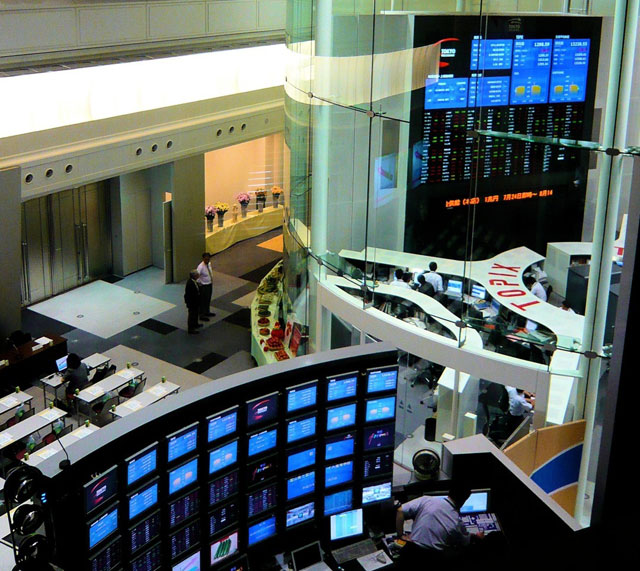Asean member states have a long way to go to harmonise their financial industries, with national interests and fears of increased competition impeding progress
By Daniel de Carteret
One charming characteristic of Southeast Asia certainly is its variety: its abundance of cultures, religions and landscapes. But when it comes to economic and financial integration, people realise that the region’s heterogeneity also has its dark side: Diversity has become a red flag that comes up during almost every discussion on financial integration.
Given the wide range of financial market developments in the region, with the shiny financial hub of Singapore on one end and Asean’s last frontier market Myanmar on the other, the way to more integration is a drive to be undertaken rather cautiously.

Asean bank assets are a case in point. Singapore’s largest bank for instance, DBS, holds $333 billion. By contrast, assets of Cambodia’s biggest bank, Acleda, and the Banque pour le Commerce Extérieur in Laos don’t even amount to 1% of the DBS sum, according to the institutions’ first-quarter results this year.
At the same time, deepening links between financial institutions also heighten the risks of contagion across the region. There are national fears that opening up domestic banking markets to foreign banks may threaten the stability of local economies. In particular in lesser-developed countries, national priorities are more pressing and may conflict with regional demands.
Yet Asean is persisting, aiming to achieve a liberal economic utopia for its members with a consistent set of rules across the region. It aspires to be a level playing field for the region’s banks in all of its ten countries by 2020.
“The process of integration and consolidation will continue to be an inescapable reality as long as member states wish to remain part of the global economy,” Asean and the ADB wrote in a joint guiding study, The Road to Asean Financial Integration, published last year. “Small economies must specialise in a few things they do best to survive. They cannot expect to offer all services to all people in all market segments.”
There are two main reasons why Asean should pursue financial integration, according to Bambang Irawan, assistant director at the Finance Integration Division of the Asean Secretariat. “The first is to strengthen financial intermediation, capacity and risk management to support national and regional growth,” he said.
“The second is to cooperate to reduce vulnerabilities to external shocks and market volatility, a point that became clearer after the Asian crisis of 1997 and is underscored by the present global financial crisis.”
In theory, borders will fall, markets will open, liquidity will be more readily available, economies of scale will drive down costs and the region will become more resilient to a financial disaster. But in practice, it is much more complex.
“Asean integration encompasses many aspects from the free flow of trade and data to human resources and capital. All of these don’t have to happen at the same time,” said Chea Serey, director general of the National Bank of Cambodia. “Many issues would need to be addressed before full integration can happen, including regulatory harmonisation, financial stability, cross-border crisis resolution, infrastructure and capacity building.”
In remembrance of the 1997 Asian financial crisis, when the devaluation of currencies spread across the region, and with the backdrop of the recent European Union financial meltdown, which saw bailouts for whole countries such as Greece, Portugal and Ireland, central bankers and their governments are nervous.
“Financial integration will strengthen the financial dependence, because capital from any country can flow, but we know that strengthening financial interdependence also strengthens the mechanism for contagion,” said James Villafuerte, an economist with the ADB’s Office of Regional Economic Integration. “Say Maybank, who takes deposits and extends loans, suddenly collapses one day. Whose deposits will first be paid – depositors in Singapore, the Philippines or Malaysia?”
Strengthening regional supervision and regulations will be needed to mitigate the risks of contagion, but Asean harmonisation is still far from complete, particularly when it comes to the lesser developed countries such as Cambodia, Laos, Myanmar and Vietnam, which are struggling to set their own internationally accepted standards, Villafuerte added. “The private sector and the government sector and the policymakers are all very skeptical about some of the intended costs,” he said.

In addition, there are calls to extend the regional liquidity safety net beyond the Chiang Mai Initiative Multilateralisation (CMIM). Originating from a response to the 1997 Asian financial crisis and the collapse of Lehman Brothers in 2008, the CMIM is a pool of foreign exchange reserves.
The currency swap arrangement, the key agreement of the Chiang Mai Initiative, draws on a foreign exchange reserve worth $240 billion in 2012 – doubled in May 2012 after a meeting in Manila – to act as a shield against global financial shocks at a time of crisis when liquidity dries up.
But the CMIM hasn’t yet been properly tested and there is still room for improvement according to Kensuke Tanaka, head of the Asia desk at the OECD Development Centre. “There is an increasing need to enhance the capacity of monitoring – in particular capital flows – and risk identification in the region,” Tanaka said. “The Chiang Mai initiative is a good quantitative initiative especially for the liquidity problem and the contagion effect.
However, in the long-term, it is important to strengthen the financial market,” he added. Commercial banks are by far the most important type of financial institutions in Asean member states. Overall, they accounted for more than 82% of total financial assets in Asean in 2009. For Brunei, Cambodia, Myanmar, Laos and Vietnam, the share was even higher, at 98%, according to ADB data.
And they haven’t needed an Asean deadline to expand. The market has already well and truly begun the integration process. International banks such as ANZ, HSBC and Standard Chartered are well entrenched in the region, with the latter having a presence in every Asean country. Asean banks such as Malaysia’s Maybank, which also has a full coverage, and Singapore’s United Overseas Bank (UOB) are also well established.
Nonetheless, deeper integration means knocking down more barriers and increasing competition. Smaller banks in the region will go up against their larger regional and international competitors whose capabilities are far more advanced.
The ADB study makes note of this using ominous language: “Cross-border banking integration does not exclude the possibility that the domestic banking market will eventually be dominated by foreign banks. Many national supervisors may think that the stability of their domestic banking markets would be seriously threatened if domestic players were to be virtually replaced by foreign competition,” it continued.
The Asean banking integration framework – though yet to be ratified – is the tool that seeks to manage the complex nature of diversity and the uneven development that exists in the region.
Assistance in training and experience from the larger Asean members such as Singapore, Thailand and Malaysia is to be passed on to member states that are still focused on strengthening their own institutions, while less developed economies are allowed more time to fully open up their banking markets. In addition, regional harmonisation is progressing at the same time, though the prioritisation of some regulations is ahead of others.
“The diversity of financial market developments, economic structure and priorities among Asean members is a key challenge in the implementation of the Asean Banking Integration Framework,” said Lim Cheng Teck, CEO of the Asean division at Standard Chartered Bank. “However, the framework will allow banks that are well-managed and have the requisite capacity more flexible access to the integrated market, thereby creating institutional standards for the region.”
As outlined in the banking integration framework, those standards will be led by “high-quality” Asean banks that meet a criteria that includes minimum capital requirements, accounting transparency standards and restrictions on exposure.

Qualified Asean banks, as they are known, will set the benchmark for regulatory standards and will be allowed, in principle, to operate under the same set of rules in any of Asean’s ten member states.
One likely candidate for the upgraded status is Singapore’s UOB, but, just like with their regional expansion, it hasn’t relied solely on Asean opening up the markets, but have done it itself.
“In Myanmar, UOB was among the first foreign banks to open a representative office in Yangon in 1994, and one of the first banks to establish a correspondent banking network with local Myanmar banks,” said Jimmy Koh, head of investor relations and research at UOB.
“We are also working with the Central Bank of Myanmar and the Myanmar Banks Association to provide training, workshops and study tours for local banks in the areas of trade and payment processing, trade finance and credit risk management,” he added.
Despite Asean’s best efforts to ease the pain, there will be winners and losers throughout the integration process.
“Financial institutions need to look at what their opportunities are now that financial integration is approaching. There is room to specialise and there is room for mergers and acquisitions,” said Beat Monnerat, senior managing director and head of financial services for Asean at financial consultancy firm Accenture.
“Successful transactions are the ones that involved not only proper due diligence before the deal but also a carefully followed plan for integration afterwards. Too many times, companies only think about the work beforehand – to get the deal across the line – rather than the importance of making sure integration runs smoothly afterwards.”
One indicator used to track integration is the amount of intra-Asia bond holdings, which rose from 13.6% in 2011 to 14.8% in 2012. Intra-Asia equity holdings have risen from 22.8% to 25.2% over the same period, according to the ADB.
Another measure is intra-regional foreign direct investment and bank lending, and despite a drop of 7.6% to Asia to $416 billion, the share of Asia’s intra-regional investment increased to 58.1% in 2012 from 55.1% in 2011.
But despite these upwards trends and the proclaimed benefits of integration, Asean decision-makers remain tentative, according to the ADB’s Villafuerte. What’s more, under Asean’s consensus-based approach, every member has a veto, meaning controversial issues remain unresolved until a unanimous agreement can be reached.
Villafuerte points to two main concerns: one worry is “the issue of competition”, while the other anxiety is that “the political appetite to really go full-steam with financial integration is very low”, he said. “Asean decision-makers have seen what is happening in Europe and they are quite scared.”


